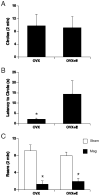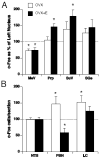c-Fos induction by a 14 T magnetic field in visceral and vestibular relays of the female rat brainstem is modulated by estradiol
- PMID: 20553875
- PMCID: PMC2925236
- DOI: 10.1016/j.brainres.2010.06.002
c-Fos induction by a 14 T magnetic field in visceral and vestibular relays of the female rat brainstem is modulated by estradiol
Abstract
There is increasing evidence that high magnetic fields interact with the vestibular system of humans and rodents. In rats, exposure to high magnetic fields of 7 T or above induces locomotor circling and leads to a conditioned taste aversion if paired with a novel taste. Sex differences in the behavioral responses to magnetic field exposure have been found, such that female rats show more locomotor circling and enhanced conditioned taste aversion compared to male rats. To determine if estrogen modulates the neural response to high magnetic fields, c-Fos expression after 14 T magnetic field exposure was compared in ovariectomized rats and ovariectomized rats with estradiol replacement. Compared to sham exposure, magnetic field exposure induced significantly more c-Fos positive cells in the nucleus of the solitary tract and the parabrachial, medial vestibular, prepositus, and supragenualis nuclei. Furthermore, there was a significant asymmetry in c-Fos induction between sides of the brainstem in several regions. In ovariectomized rats, there was more c-Fos expressed in the right side compared to left side in the locus coeruleus and parabrachial, superior vestibular, and supragenualis nuclei; less expression in the right compared to left side of the medial vestibular; and no asymmetry in the prepositus nucleus and the nucleus of the solitary tract. Chronic estradiol treatment modulated the neural response in some regions: less c-Fos was induced in the superior vestibular nucleus and locus coeruleus after estradiol replacement; estradiol treatment eliminated the asymmetry of c-Fos expression in the locus coeruleus and supragenualis nucleus, created an asymmetry in the prepositus nucleus and reversed the asymmetry in the parabrachial nucleus. These results suggest that ovarian steroids may mediate sex differences in the behavioral responses to magnetic field exposure at the level of visceral and vestibular nuclei of the brainstem.
Copyright 2010 Elsevier B.V. All rights reserved.
Figures





Similar articles
-
c-Fos induction in visceral and vestibular nuclei of the rat brain stem by a 9.4 T magnetic field.Neuroreport. 2000 Aug 21;11(12):2681-5. doi: 10.1097/00001756-200008210-00015. Neuroreport. 2000. PMID: 10976943
-
Labyrinthectomy abolishes the behavioral and neural response of rats to a high-strength static magnetic field.Physiol Behav. 2009 Apr 20;97(1):36-43. doi: 10.1016/j.physbeh.2009.01.018. Epub 2009 Jan 31. Physiol Behav. 2009. PMID: 19419674
-
Lack of estradiol modulation of sleep deprivation-induced c-Fos in the rat brain.Physiol Behav. 2008 Nov 28;95(4):562-9. doi: 10.1016/j.physbeh.2008.08.001. Epub 2008 Aug 12. Physiol Behav. 2008. PMID: 18761364
-
Fos-defined activity in rat brainstem following centripetal acceleration.J Neurosci. 1992 Nov;12(11):4489-500. doi: 10.1523/JNEUROSCI.12-11-04489.1992. J Neurosci. 1992. PMID: 1432106 Free PMC article.
-
Evidence for a cephalic site of action of high magnetic fields on the behavioral responses of rats.Physiol Behav. 2007 Nov 23;92(4):665-74. doi: 10.1016/j.physbeh.2007.05.011. Epub 2007 May 18. Physiol Behav. 2007. PMID: 17568635 Free PMC article.
Cited by
-
Head tilt in rats during exposure to a high magnetic field.Physiol Behav. 2012 Jan 18;105(2):388-93. doi: 10.1016/j.physbeh.2011.08.030. Epub 2011 Aug 31. Physiol Behav. 2012. PMID: 21903121 Free PMC article.
-
Orientation within a high magnetic field determines swimming direction and laterality of c-Fos induction in mice.Am J Physiol Regul Integr Comp Physiol. 2013 Oct 1;305(7):R793-803. doi: 10.1152/ajpregu.00549.2012. Epub 2013 May 29. Am J Physiol Regul Integr Comp Physiol. 2013. PMID: 23720133 Free PMC article.
-
Behavioral effects on rats of motion within a high static magnetic field.Physiol Behav. 2011 Mar 1;102(3-4):338-46. doi: 10.1016/j.physbeh.2010.11.028. Epub 2010 Nov 28. Physiol Behav. 2011. PMID: 21118699 Free PMC article.
References
-
- Abdel Nabi E, Motawee E, Lasheen N, Taha A. A study of vertigo and dizziness in the premenstrual period. J Laryngol Otol. 1984;98:273–5. - PubMed
-
- Arwas S, Rolnick A, Lubow RE. Conditioned taste aversion in humans using motion-induced sickness as the US. Behav Res Ther. 1989;27:295–301. - PubMed
-
- Braun JJ, McIntosh H. Learned taste aversions induced by rotational stimulation. Physiol Psychol. 1973;1:301–304.
-
- Cason AM, DenBleyker MD, Ferrance K, Smith JC, Houpt TA. Sex and estrous cycle differences in the behavioral effects of high-strength static magnetic fields: role of ovarian steriods. Am J Physiol. 2006;290:R659–67. - PubMed
-
- Cason AM, Kwon BS, Smith JC, Houpt TA. Labyrinthectomy abolishes the behavioral and neural response of rats to a high-strength static magnetic field. Physiol Behav. 2009;97:36–43. - PubMed
MeSH terms
Substances
Grants and funding
LinkOut - more resources
Full Text Sources

